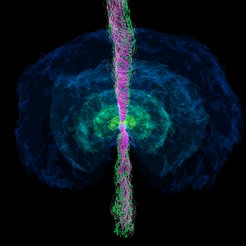Breakthrough in simulating how neutron stars collide
Longest self-consistent numerical-relativity simulation to date reveals details of black hole and jet formation and advances multi-messenger astronomy

To the point
- Record-breaking simulation: An international team led by researchers at the Max Planck Institute for Gravitational Physics (Albert Einstein Institute) has performed the longest and most complex simulation to date of a binary neutron star merger, lasting 1.5 seconds of real time.
- The full picture: The simulation, which used 130 million CPU hours, incorporates the effects of general relativity, neutrino radiation, and magnetohydrodynamics. It shows a rapid collapse to a black hole and the subsequent formation of a jet.
- Valuable predictions: The simulation predicts the emitted gravitational-wave signal, the neutrino burst signature, the kilonova, and the ejection of matter from the merger remnant. This is valuable information for the multi-messenger astronomy of future events – the observation of multiple signals from the same source.
The longest and most complex simulation
Binary neutron star mergers are prime candidates for multi-messenger astronomy. They emit gravitational waves, neutrinos and electromagnetic radiation across the entire spectrum. To make the most of future observations of these events, accurate models and predictions of the expected signals are crucial.
“Predicting the multi-messenger signals from binary neutron star mergers from first principles is extremely difficult. We have now succeeded in doing just that,” says Kota Hayashi, a postdoctoral researcher in the Computational Relativistic Astrophysics department at the Max Planck Institute for Gravitational Physics (Albert Einstein Institute) in the Potsdam Science Park. “Using the Fugaku supercomputer in Japan, we have performed the longest and most complex simulation of a binary neutron star merger to date.”
The simulation spans 1.5 seconds of real time, took 130 million CPU hours to complete, and kept between 20,000 and 80,000 CPUs busy at any one time. It includes the effects of Einstein's theory of general relativity, neutrino emission, and the interaction of strong magnetic fields with the high-density matter inside the merging neutron stars.
Jet and black hole formation from a binary neutron star merger
A complete picture
The simulation starts with very few assumptions – neutron stars with strong magnetic fields orbiting each other – and evolves the binary self-consistently over time based on basic physical principles. “Our new simulation follows the binary all the way through its evolution: inspiral, merger, and the post-merger phase including the jet formation. It provides the first complete picture of the entire process and thus valuable information for future observations of such events,” explains Kota Hayashi.
Initially, the two neutron stars (simulated at 1.25 and 1.65 times the mass of our Sun) orbit each other five times. During this inspiral phase, they fall towards each other as they lose orbital energy, which is emitted as gravitational waves. Because of the high total mass, the merger remnant promptly collapses into a black hole. The simulation predicts the gravitational-wave signal, the first of the observable multi-messenger signals.
After the merger, a disk of matter forms around the remnant black hole. In the disk, the magnetic field is amplified by the winding of the field lines and dynamo effects. The interaction with the fast spin of the black hole then further intensifies the magnetic field. This creates an outflow of energy along the rotational axis of the black hole.
“We think that this energy flow along the black hole axis, driven by magnetic fields, powers a gamma-ray burst,” says Masaru Shibata, director of the Computational Relativistic Astrophysics department. “This agrees with what we know from previous observations and provides further insight into the inner workings of neutron star mergers.”
Multi-messenger predictions
The team further uses their simulation to derive the expected emission of neutrinos from binary neutron star mergers. In addition, the simulation provides information on the amount of matter ejected into the interstellar medium and enables them to predict the kilonova – the glowing debris cloud rich in heavy elements.
This result is an important contribution to multi-messenger astronomy. It integrates predictions of gravitational-wave data, electromagnetic signals, and neutrino emissions into a self-consistent picture. “What we've learned about jet formation and magnetic field dynamics is crucial for our interpretation and understanding of neutron star mergers and their associated counterparts,” explains Masaru Shibata.













